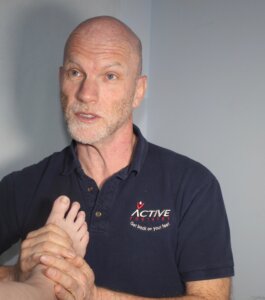What are the chances of rupturing your Achilles?

A question I am often asked by patients presenting with Achilles tendon pain is, “Will my tendon snap if I keep running on it?” In fact fear of Achilles tendon rupture is one of the main reasons that active people stop exercising after an Achilles tendon injury. But are those fears justified? As always, it is helpful to look at the facts to find out what the risk factors are for rupture of the Achilles tendon.
Firstly, Achilles tendon rupture does not happen in a vacuum, and healthy tendons rarely rupture. There is nearly always a history of degeneration in the tendon first, and this ensuing weakness can certainly increase the risk of rupture. Even in the young athlete where the rupture is apparently spontaneous with no previous history, degenerative changes have been found on scanning the tendon post injury. So a healthy tendon is extremely unlikely to rupture.

Secondly, the risk does increase with age, especially in males, so a combination of being an older athlete with a history of Achilles tendon problems does put you at a relatively higher risk of an Achilles rupture. Of course, certain sports such as running and jumping sports which place high loads on the Achilles tendon can also increase the risk across all age groups.

A helpful analogy is to think of a brand-new elastic band out of the packet compared to an old elastic band kept at the back of the drawer. Clearly a new elastic band will have more stretch capacity than the old one and is less likely to snap when stretched. Of course as humans, unlike elastic bands, we have powers of regeneration and to an extent can convert old to new by rehabilitating our tendons, more of which later.
Finally, certain medications such as Fluoroquinolone antibiotics and steroid injections have been shown to weaken the Achilles tendon, increasing the risk of a rupture.
The good news is that, whilst the incidence of Achilles tendon ruptures is increasing, possibly due to an increasing active older population and more sport participation overall, the percentage of such injuries is quite small at around 4% or 36 patient per 100,000 according to differing population studies. So even if you are unlucky enough to have an Achilles tendon injury, the odds of you getting a rupture are quite small.
However, this does not mean you should be complacent if you have an Achilles tendon injury. It can be hard to know when and how you should return to exercise, and a proper structured rehabilitation plan after Achilles tendon injury helps to build strong healthy type 1 Collagen in the injured tendon, increasing its load capacity and significantly reducing your risk of rupture. It is important that this process is guided by a suitably qualified health professional.
If you do not have any Achilles injury or painful symptoms but are involved in active sports such as running, tennis or netball/basketball, then it is smart to keep your tendon in good condition by regular strengthening exercises in particular targeting the posterior chain muscle groups such as the calf, hamstring and gluteal muscles, as weakness in these structures can increase stress on the Achilles tendon.
How can Podiatry help?

Sports Podiatrist
As a Sports Podiatrist, I am trained to recognise the early warning signs of Achilles tendon rupture, and during a typical injury assessment will ultrasound scan the tendon to check for any degeneration which may be a risk factor for rupture of the tendon. A comprehensive treatment plan using a combination of tendon load management, rehabilitation exercises, and laser/shockwave therapy to relieve pain and stimulate a healing response in the tendon is the very best way to get you back to activity without fear of rupture.
The road to recovery after a tendon rupture is a very long one, possibly requiring surgery, so this is definitely one of those scenarios where prevention is better than cure!